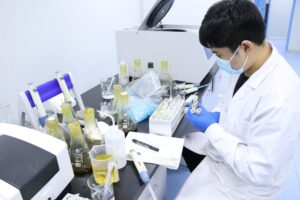Feed costs account for up to 70% of production expenses in animal agriculture. Farmers are always looking for ways to conserve feed, reduce waste and improve productivity to increase cost-efficiency. Some of the most useful tools for optimizing feed utilization are high-quality, functional feed additives that provide nutritional and protective benefits at a low cost relative to their returns. By supporting diet optimization, gut health and growth, certain additives yield a competitive advantage.

Additives like enzymes, probiotics, prebiotics, organic acids, phytochemicals and trace minerals can replace a portion of expensive protein ingredients or improve the nutritional availability and digestibility of existing diet components. They produce positive effects such as:
•Unlocking nutrients bound up in feedstuffs like phytate phosphorus or non-starch polysaccharides. This reduces supplementation needs.
• Creating a favorable gut environment for nutrient absorption and microbial balance. This improves feed conversion and growth.
•Preventing disease and reducing pathogens to support health and performance. This decreases mortality, morbidity and the use of medications.
•Providing antioxidants and anti-inflammatory effects. This enhances well-being and productivity.
•Minimizing environmental pollution from manure and runoff by enabling better utilization of diet components. This answers consumer and regulatory concerns.
Desire: Using strategic additives gives farmers competitive advantages through:
•Lower feed costs from reduced crude protein levels and less waste. This expands tight profit margins.
•Maximized growth and productivity through improved nutrition and health. This increases yields and profits.
•Decreased animal loss and veterinary expenses. This prevents unforeseen costs that significantly impact the bottom line.
•Higher product quality and value. This builds consumer trust and loyalty in an operation’s products.
•Compliance with regulations on efficiency and waste mitigation. This safeguards access to markets.
•Improved sustainability and environmental stewardship. This supports a responsible long-term business model.
To leverage the benefits of low-cost, high-performing additives, follow these steps:
1. Identify the highest-cost and highest-waste areas of your current feed program. Then match appropriate additives to improve efficiencies based on scientific evidence and expert guidance.
2.Determine the optimal inclusion rates to meet animal requirements for maximum cost-effectiveness. Start at a low level and adjust based on responses.
3.Closely monitor key metrics related to factors such as growth, health status, productivity, and product quality to quantify the impact of additives. Compare against your baseline to demonstrate the value.
4. Keep detailed records of feed usage, feed conversion ratios, performance benchmarks and productivity volumes before and after incorporating additives. Track your cost-saving and returns on investment over time.
5.Stay up-to-date with innovations in feed additives and delivery technologies. A rapidly developing area of science will continue to unlock new opportunities for efficiency and precision animal nutrition.
Additives provide an affordable way to gain a competitive edge by optimizing margins through nutrition and performance. By tapping into their secret potential, farmers across the supply chain access an open secret to sustainability: safeguard your future by saving at the source—starting with strategic, data-proven additions to the feed. Nourish cost-efficiency, harvest security.

